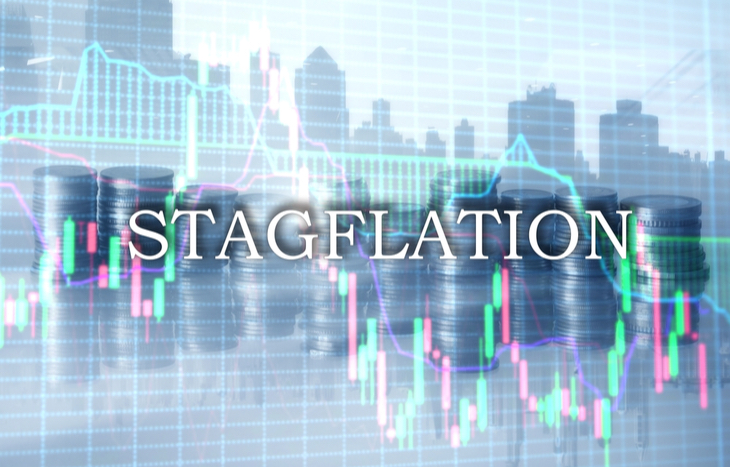What is Stagflation?

Stagflation seems to be a word that we’ve been hearing a lot of recently. With the CPI report showing that inflation had slowed less than expected, stagflation concerns became even louder. However, for the average person, the term probably has never been defined. So, what is stagflation? Today we’ll look at what stagflation is, as well as how it impacts you and the broader economy.

Inflation
First things first, we should probably define what inflation is. The simplest way to define inflation is as the erosion of a currency’s purchasing power. Those moments where it feels like your dollar buys less than it used to are examples of inflation. Under economic theory, inflation primarily occurs when the growth of the money supply outpaces economic growth. For this reason, when inflation becomes an issue, central banks will attempt to limit the money supply. Essentially if more money is introduced to an economy, without an equal introduction of goods and/or services, inflation occurs. Other contributing factors include rising cost(s) of goods, wages and labor. The U.S. Federal Reserve aims for an inflation rate of 2%, and has averaged that since 2011.
Stagflation Defined
So, now that we know what inflation is, we can address what stagflation is. If inflation alone has the power to impact markets and basic economies, what impacts can stagflation have? To simply define stagflation, allow me to present it as an equation or two:
- Stagflation = High Inflation + Slow Economic Growth + High Unemployment
- Stagflation = High Inflation + Decreasing GDP
Under the first equation, we aren’t yet in a period of stagflation. While inflation is high, the official unemployment rate is 3.6%. That level reasonably mirrors the level that we were at prior to the onset of Covid back in 2020. However, the labor participation rate is still below pre-pandemic levels by a full percentage point. While that may not sound like a lot, remember that equates to hundreds of thousands of people not participating in the labor force.
With that being said, based on the second equation, we are already experiencing a period of stagflation. The U.S. GDP declined by 1.4% in Q1 of 2022, when it was expected to grow by 1%.
An example of stagflation in the U.S. would be the America of the early to mid 1970s. During this time, the United States experienced two, separate, recessions. There were also four separate years of negative GDP growth, two of which being consecutive. Inflation skyrocketed from 3.6% in 1973 to 8.3%, incidentally, where we are now, to 1974. The closest unemployment was to the 3.6% we have now was 1970 and 1973, when it was 4.9%. In 1975, unemployment was 8.5%.
Impacts and Concerns
So, how does stagflation impact you? Well, first, through the basic inflationary impacts. Let’s say your investments are down 5% this year, better than the broader markets. Tack on 8.3% in inflationary costs, and your money is actually worth 13.3% less. Inflation and bonds have a well-defined history as well. Inflationary risks and different securities have well defined relationships such as the relationship with bonds and the inflation rate. If your bond pays 3%, but inflation rises from 2% to 6%, you are losing money on the investment. Let’s look at your paycheck too. If you got a 5% raise, but inflation went up from the 2% average to 8.5%, your real earnings went down 1.5%. In sum, high inflation hits you at every angle. You effectively make less, your investments return less/negative, and things get more expensive.
Second, looking at the other variable(s) in the equation. What do all of unemployment being high, GDP decreasing, and economic growth slowing mean? Essentially, it means that the average person is at risk of losing their job. Adding the increased costs of goods and services to a loss of income can cause incredible financial strife. Now, apply that on a national level. If more people are out of work, you would also expect less spending. If the average person is unable to stimulate the economy, via spending, it is hard to reverse poor economic growth.
There is also a less direct impact, though perhaps one even more impactful. With the national debt burgeoning in the last two years, financing that debt also becomes more difficult. Discussing the national debt in its current context is an issue deserving its own space. Thankfully, others have already attempted to broach the subject.
Solutions
There is no surefire way to solve or fix stagflation. The general consensus is to first engage in the policies that address inflation. Examples of that would be printing less money and increasing interest rates, as to make borrowing more expensive. Other, less popular, examples would be cutting different government programs/expenditures. Next would be efforts to stimulate the economy, with the simplest being lowering taxes. That is also a complex suggestion to make, and agreeing to a proper execution is usually quite difficult. In addition, without the aforementioned spending cuts, the potential impact is greatly reduced.
Conclusions on Stagflation
There is no question that inflation is currently negatively impacting people. Concerns about global conflicts, and potential recessions, do nothing to assuage the average person’s concerns. Depending on how we look at it, America is already experiencing a period of stagflation. On the inflationary front, the Fed has begun increasing interest rates. Whether or not tax breaks and spending cuts follow are unclear, though admittedly a more accurate term might be unlikely.
In times like these, having a financial plan is important. While you cannot control the rate of inflation, you can control things like your spending and your investments. Even if it doesn’t eliminate it, proper financial planning should help minimize the detrimental impacts of stagflation.






